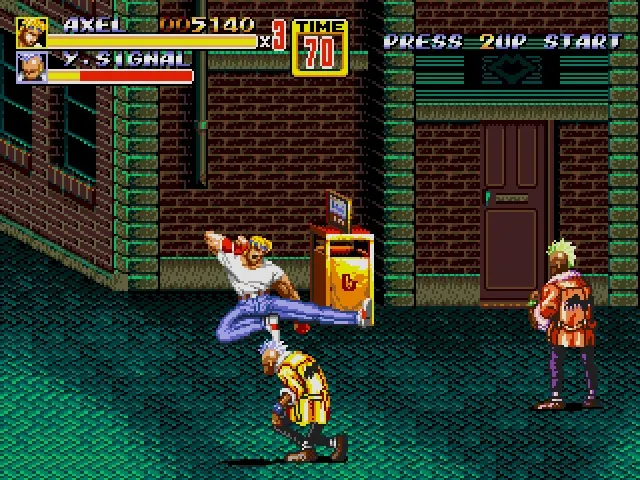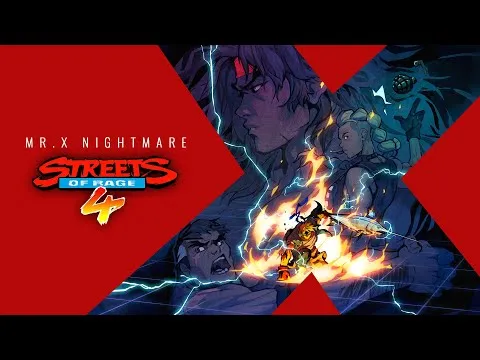
This post is avaliable in both English and Spanish (translated with DeepL translator). All screenshots were taken by me.
If you want to read it in English, just scroll below. If you want to read it in Spanish, press CTRL+F and type "-ESP-" (without quotes) on the bar that shows up to get to the Spanish version immediately. Alternatively, just keep scrolling down until the end of the English section.
Este post está disponible en ambos Inglés y Español (traducido con DeepL). Todas las fotos fueron tomadas por mí.
Si quieres leerlo en inglés, solo sigue abajo. Si quieres leerlo en español, presiona CTRL+F y escribe "-ESP-" (sin comillas) en la barra que aparece para llegar a la versión en Español inmediatamente. Alternativamente, solo sigue bajando hasta el final de la sección en Inglés.
English
Yesterday I had written about Jet Set Radio Future Multiplayer, an interesting fanmade port of an old classic with online multiplayer which shows what fans can do for a franchise. However, with the theme of fan support sometimes bringing franchises back to life with new titles (which isn't the case for JSR yet) and revitalizing old legends, what Streets of Rage 4 is indeed fitting for this topic.
The beat'em up genre has quite the history in videogames, mainly as arcade games (which would get ported to consoles) and later on a revitalization of the genre with the rise of indie and retro throwback games. A legendary franchise which had been dormant for more than a decade had their big comeback at this time thanks to a dedicated team.
Streets of Rage was a quite beloved trilogy on the SEGA Genesis/Megadrive, unique in that they were designed for that console instead of being an arcade port yet having so much visible quality, and also does show the evolution of the developers and the hardware when comparing the launch title that was the first game, with its two sequels that improved everything. With Yuzo Koshiro's stellar compositions complementing the captivating enviroments and satisfying gameplay, this franchise was destined to be a classic for many...but ended up inactive for several years just like other beloved classic SEGA IPs.
There are cases like Panzer Dragoon, Shenmue and House of the Dead which only recently got new games/remakes after so long, but others like Ristar, Burning Rangers and Jet Set Radio haven't got a new chance to shine again, and Streets of Rage used to be a notably egregious case with how popular it was yet ended up fading after a single trilogy on the Genesis. However, after being stuck to references and cameos (like in Project X Zone 2), the year of 2021 delivered with a reveal of a long-awaited new entry, and while the visual style revealed at first brought some doubts to the players, the release of the game would put an end to all and any fears about disappointment.
The roster of playable characters includes Axel and Blaze from the previous games (except visibly older), Floyd and Cherry which are new to this game but are connected to past characters, and Adam which was only playable in the first game and is unlockable here. Every character feels unique with their moveset and attributes, and on top of these, you can also unlock the characters exactly as they appeared in the previous three games (SOR1 characters being quite limited in moves as in that game, but cause more damage with their attacks).
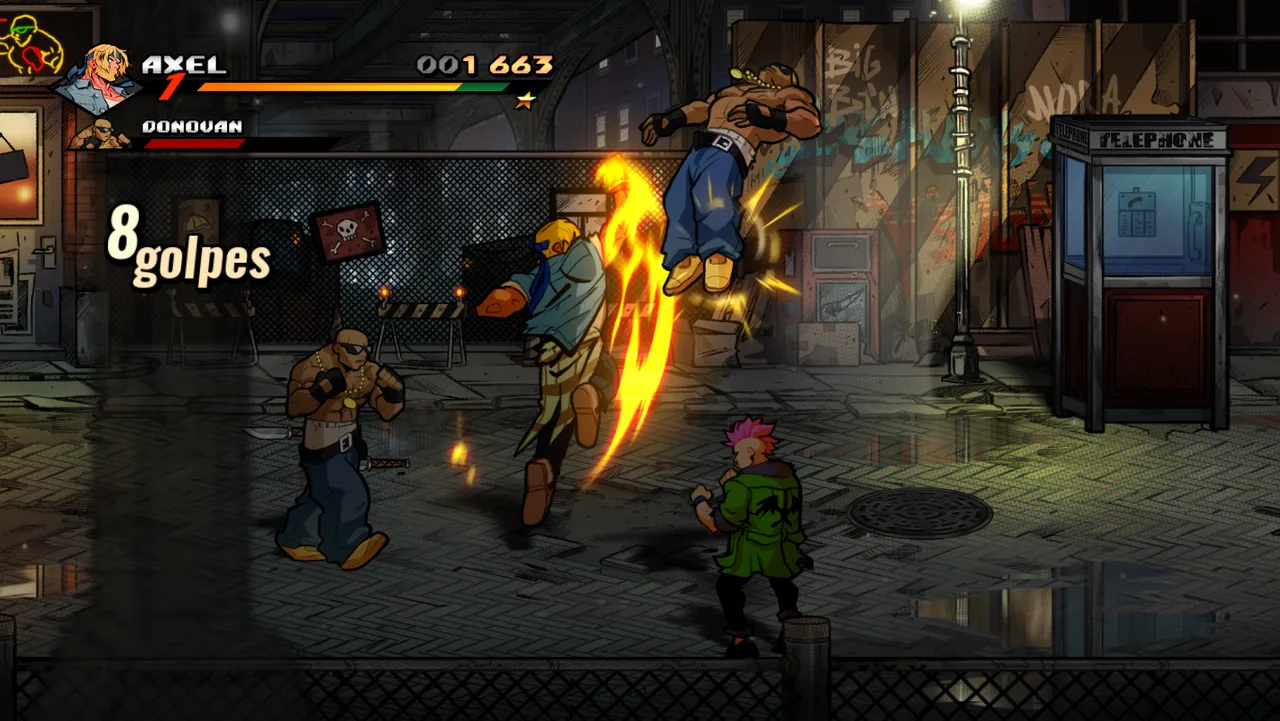
The fan service for retro SOR fans doesn't stop there: In several stages there's an arcade cabinet that, if you hit it with a taser (which you can get from certain enemies), you'll get warped to a boss fight taken from Streets of Rage 2 (with the music, stage and boss itself looking exactly like they did). Even more, there's also an option to use the music from the classic SOR trilogy ingame, which not only still holds up today quite well, but also is brilliant in the way the music tracks were handpicked to fit for each stage and moment.
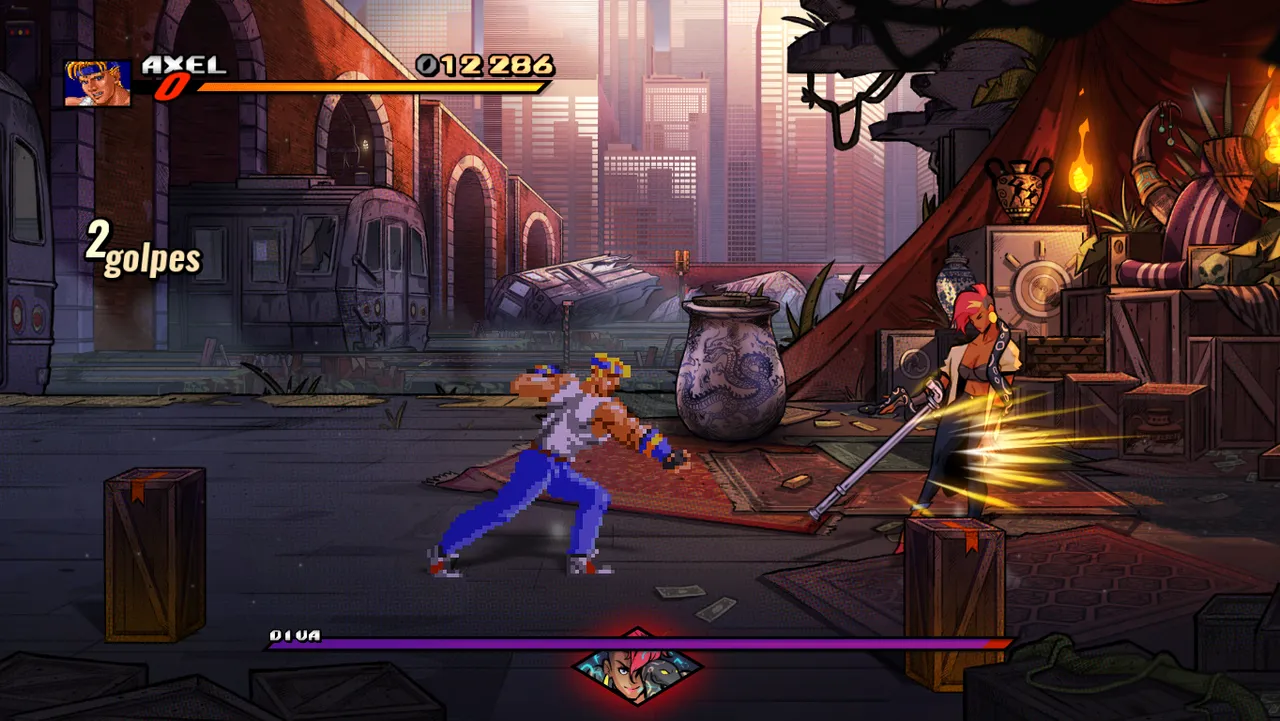
Regarding gameplay, this is an incredibly satisfying game not only because of the visual and sound design making your attacks have a lot of impact, but also because of the modern tweaks this game gave to the classic formula. Unlike the previous games, here you can actually juggle airborne enemies with your attacks no matter what, so you can give quite a lot of damage from combos now. Special attacks consume a bit of health when used, but said health spent can be restored by attacking enemies; you'll lose that chance if you get hit once though. There are also Star Attacks, which require stars to use but there is no health penalty, have a huge range and are quite powerful.

The presentation is incredibly polished: The artstyle ends up giving a lot of identity to the game as both characters and enemies are drawn in high resolution and with smooth animation, which are complemented by a lightning engine that applies shades of colors over the sprites depending of the enviroment. The music is also top notch, with Yuzo Koshiro returning to make some tracks along with modern composers, with the atmospheric but energetic style of many tracks living up to the frantic gameplay and the franchise's reputation.
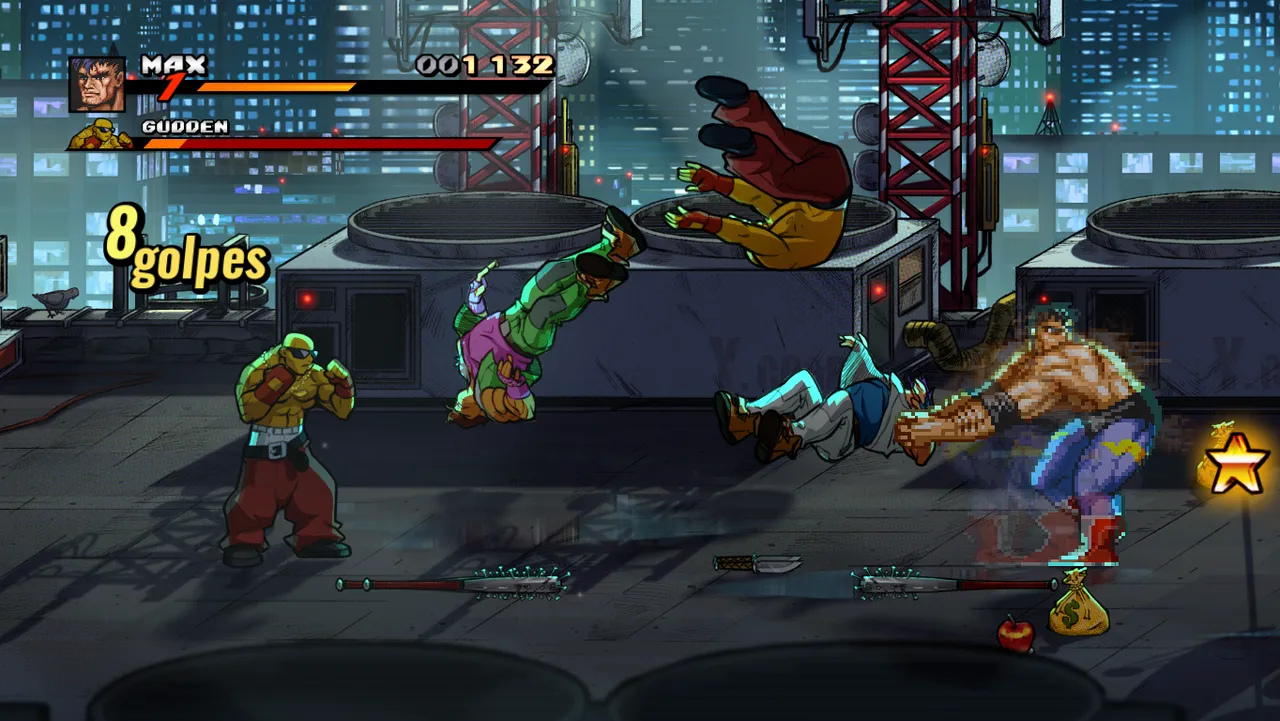
I can't really put any further words other than that the attention to detail with this game is incredible and is really fun to play, specially in multiplayer in which case it supports 4 players in co-op and versus modes (along with online support). With the bosses being challenging yet fun and balanced thanks to the added visual cues for attacks to watch out as well as your expanded moveset, this is a huge blast to play. It is also quite accessible with several difficulty options and the story mode by default saving at the beginning of each stage, so it is infinitely more convenient than being forced to beat it with limited or no continues on a single run (which you can attempt with the unlockable Arcade mode).
It is particularly known recently that DotEmu has been giving many retro games their blessing to return with modern entries (which makes sense considering their huge historial of porting old games), like the Monster Boy remake, Windjammers 2 and TMNT Shredder's Revenge. It is wonderful how passionate they are on each and every project like this, and Streets of Rage 4 is quite a shining example not only from the base game, but also with the patches and upcoming DLC with new modes, moves, characters, and music composed by Tee Lopes (mainly known for his work on Sonic Mania)!
For those that were awaiting a good old beat' em up classic to play with, this gem of a game that gives a huge modern makeover to the beloved Streets of Rage is undoubtedly a must-get. And if you were wondering if I would mention it, I'm also aware of the fanmade Streets of Rage Remake which is also definitely worth making a post of one day (and was made several years before SOR4).
Español -ESP-
Ayer había escrito de Jet Set Radio Future Multiplayer, un interesante port hecho por fans de un clásico viejo con multijugador online que demuestra lo que los fans pueden hacer por una franquicia. Sin embargo, con el tema de soporte por fans a veces trayendo de vuelta a la vida a franquicias con nuevos títulos (el cual aún no es el caso para JSR y revitalizar viejas leyendas, lo que hizo Streets of Rage 4 encaja bastante para este tema.
El género de los beat'em ups tiene una gran historia en los videojuegos, principalmente como juegos de arcade (que serían portados a las consolas) y más tarde una revitalización del género con el auge de los juegos indie y retro. Una franquicia legendaria que había estado inactiva durante más de una década tuvo su gran regreso en esta época gracias a un equipo dedicado.
Streets of Rage fue una trilogía bastante querida en la SEGA Genesis/Megadrive, única por haber sido diseñada para esa consola en lugar de ser un port de arcade y, sin embargo, tener tanta calidad visible, y también muestra la evolución de los desarrolladores y del hardware al comparar el título de lanzamiento que fue el primer juego, con sus dos secuelas que lo mejoraron todo. Con las composiciones estelares de Yuzo Koshiro complementando los cautivadores entornos y la satisfactoria jugabilidad, esta franquicia estaba destinada a ser un clásico para muchos... pero acabó inactiva durante varios años al igual que otras queridas IPs clásicas de SEGA.
Hay casos como el de Panzer Dragoon, Shenmue y House of the Dead, que recientemente han recibido nuevos juegos/remakes después de tanto tiempo, pero otros como Ristar, Burning Rangers y Jet Set Radio no han tenido una nueva oportunidad de brillar de nuevo, y Streets of Rage solía ser un caso notablemente atroz con lo popular que era, pero acabó desapareciendo después de una única trilogía en la Genesis. Sin embargo, después de quedarse en referencias y cameos (como en Project X Zone 2), el año 2021 llegó con la revelación de una nueva entrada muy esperada, y aunque el estilo visual revelado al principio trajo algunas dudas a los jugadores, el lanzamiento del juego pondría fin a todos y cada uno de los temores de decepción.
La lista de personajes jugables incluye a Axel y Blaze de los juegos anteriores (excepto los visiblemente más viejos), Floyd y Cherry, que son nuevos en este juego pero están conectados con los personajes del pasado, y Adam, que sólo era jugable en el primer juego y es desbloqueable aquí. Cada personaje se siente único con su conjunto de movimientos y atributos, y además de esto, también puedes desbloquear los personajes exactamente como aparecían en los tres juegos anteriores (los personajes de SOR1 están bastante limitados en movimientos como en ese juego pero hacen mas daño con sus ataques individuales).

El fan service para los fans de SOR retro no se detiene ahí: En varias fases hay un mueble arcade que, si lo golpeas con una pistola eléctrica (que puedes conseguir de ciertos enemigos), te llevará a un combate contra un jefe sacado de Streets of Rage 2 (con la música, el escenario y el propio jefe con el mismo aspecto). Además, existe la opción de utilizar la música de la trilogía clásica de SOR en el juego, que no sólo sigue siendo bastante buena, sino que también es brillante por la forma en que se han elegido las pistas musicales para que encajen en cada fase y momento.

En cuanto a la jugabilidad, se trata de un juego increíblemente satisfactorio, no sólo por el diseño visual y sonoro que hace que tus ataques tengan mucho impacto, sino también por los ajustes modernos que este juego ha dado a la fórmula clásica. A diferencia de los juegos anteriores, aquí puedes hacer malabares con los enemigos en el aire con tus ataques sin importar lo que ocurra, por lo que ahora puedes hacer bastante daño con los combos. Los ataques especiales consumen un poco de salud cuando se usan, pero dicha salud gastada se puede recuperar atacando a los enemigos; sin embargo, perderás esa posibilidad si te golpean una vez. También hay ataques estelares, que requieren estrellas para usarse pero no hay penalización de salud, tienen un gran alcance y son bastante poderosos.

La presentación está increíblemente pulida: El estilo artístico acaba dando mucha identidad al juego, ya que tanto los personajes como los enemigos están dibujados en alta resolución y con animaciones suaves, que se complementan con un motor de iluminación que aplica tonos de colores sobre los sprites dependiendo del entorno. La música también es de primera, con Yuzo Koshiro volviendo a hacer algunos temas junto con compositores modernos, con el estilo atmosférico pero enérgico de muchos temas a la altura de la frenética jugabilidad y la reputación de la franquicia.

No puedo poner más palabras que la atención al detalle de este juego es increíble y es realmente divertido de jugar, especialmente en el modo multijugador, que admite 4 jugadores en los modos cooperativo y versus (junto con el soporte online). Los jefes son desafiantes, pero divertidos y equilibrados gracias a las señales visuales añadidas para los ataques que hay que tener en cuenta, así como su conjunto de movimientos ampliado. Además, es bastante accesible, con varias opciones de dificultad y el modo historia guardando por defecto al principio de cada fase, por lo que es infinitamente más cómodo que verse obligado a superarlo con continuaciones limitadas o sin ellas en una sola carrera (algo que puedes intentar con el modo Arcade desbloqueable).
Últimamente se sabe que DotEmu ha dado su bendición a muchos juegos retro para que vuelvan con entradas modernas (lo que tiene sentido teniendo en cuenta su enorme historial de portar juegos antiguos), como el remake de Monster Boy, Windjammers 2 y TMNT Shredder's Revenge. Es maravilloso lo apasionados que son en todos y cada uno de los proyectos como éste, y Streets of Rage 4 es todo un ejemplo, no solo por el juego base, sino también por los parches y el próximo DLC con nuevos modos, movimientos, personajes y música compuesta por Tee Lopes (conocido principalmente por su trabajo en Sonic Mania)!
Para aquellos que estaban esperando un buen beat' em up clásico para jugar, esta joya de juego que da un gran lavado de cara moderno al querido Streets of Rage es, sin duda, una compra obligada. Y si te preguntabas si lo mencionaría, también estoy al tanto del Streets of Rage Remake hecho por fans, que también merece la pena que hable de este algún día (y se hizo varios años antes que SOR4).
